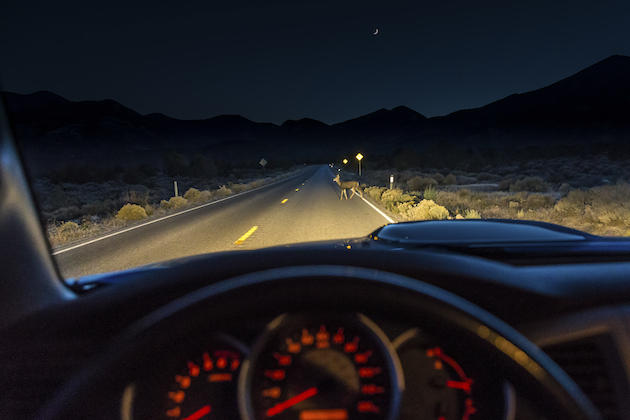No, you didn’t read the title wrong. The best thing you can do when a deer is in the headlights and you can’t slow down is to hit it straight on.
That’s what research by the US Forest Service has found. USFS wildlife biologist Sandra Jacobson analyzed wildlife-vehicle collisions to reduce their frequency by Forest Service personnel. Her research led to an agency documentary, entitled “Avoiding Wildlife-Vehicle Collisions,” which won a bronze Telly Award in 2013. What she found upsets common misconceptions about how to avoid collisions—and no, deer whistles don’t work.
Jacobson told the Billings Gazette people have a mistaken idea of natural selection when it comes to wildlife and vehicles.
“People assume deer will learn to look both ways, and the dumb ones will be selected out of the population,” said Jacobson. “That’s not going to happen.
“You think surely they will figure out they have to move, yet sometimes they make the completely incorrect response. That’s because they have sensory perceptions that make that impossible to happen.”
The danger lies in the eyes. Deer have prey vision—eyes that sit on the sides of their heads rather than eyes that sit in front and offer binocular vision. When a deer sees bright lights coming in the darkness, they are able to see the beams growing larger, but don’t correlate that with the car growing closer. Their brains are stuck trying to understand the sensory information while the vehicle barrels closer.
Most wrecks end with the animal being killed, regardless of what the driver does. Most humans, on the other hand, are injured or die from trying to avoid the animal. The research showed the driver should directly hit the deer rather than swerving off the road and further endangering the vehicle occupants.
Some drivers slam on the brakes right until they hit the animal, then left off. The action causes a lot of problems, especially on wildlife larger than a white-tailed deer.
“That’s particularly important when you’re dealing with larger animals, like elk or moose,” Jacobson said. “When a passenger vehicle hits a moose, it knocks the legs out and the moose comes through the passenger cabin. Your chances of dying with a moose collision are considerably higher because of that.”
Jacobson said a good way to avoid collisions is to be aware of where and when they often happen. Deer move at dusk and dawn, use stream beds as corridors, and cross near bridges when the underpasses are too low or narrow for them to cross underneath. The roads most likely to see collisions are two-lane roads with a speed limit of 55 mph: Deer avoid larger highways and lower speed limits increase the amount of time a driver has to react.
There are 1.2 million wildlife-vehicle collisions reported on an average year. Of those, roughly 2,600 involve injury and 200 result in death.
The Forest Service encounters a large share of those collisions due to the terrain and roads personnel are required to travel. Wildlife collisions make up the top two causes of accidents and property damage for the agency.
Cover image: Thinkstock

